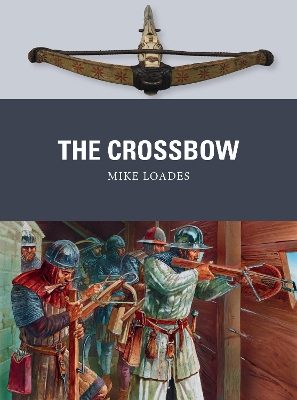Weapon
2 primary works • 3 total works
Book 43
An ancient design, emerging from Central Asia in the second millennium BC, the composite bow was adopted by a staggering variety of cultures, from nomadic tribal peoples such as the Huns, Turks and Mongols, to mighty empires such as the Romans, Byzantines, Persians, Arabs and Chinese. Offering high power and portability, the composite bow was an ideal cavalry weapon, though it was also used by infantry in open battle and as a siege weapon. In this important study, an expert on Eastern military technology tells the story of this extraordinary piece of military hardware; how it was made and how various cultures developed differing tactics for using it. He explains why the composite bow achieved such stunning successes and how it endured as a weapon of choice for thousands of years.
Book 61
Technologically sophisticated and powerful, the crossbow has long enjoyed a popular reputation for villainous superiority because it could be used with little training as a weapon of assassination. The study of bow designs, trigger mechanisms and spanning devices reveals a tale of considerable mechanical ingenuity; advances that produced a battlefield weapon requiring comparatively little training to use. It was an extremely useful weapon, and especially effective in siege warfare for both attack and defence.
Known to the Ancient Greeks and the Chinese as early as the 5th century BC, the crossbow developed both in Western Europe and in the Far East. Advances in trigger mechanisms, spanning and bow design allowed the development of ever more powerful bows. In this study acknowledged weaponry expert Mike Loades traces the origins, development, combat record and lasting legacy of the crossbow, the formidable projectile weapon that played a key role in a host of battles and sieges across Europe and Asia.
Known to the Ancient Greeks and the Chinese as early as the 5th century BC, the crossbow developed both in Western Europe and in the Far East. Advances in trigger mechanisms, spanning and bow design allowed the development of ever more powerful bows. In this study acknowledged weaponry expert Mike Loades traces the origins, development, combat record and lasting legacy of the crossbow, the formidable projectile weapon that played a key role in a host of battles and sieges across Europe and Asia.
An iconic medieval missile weapon, the deadly longbow made possible the English victories at Crecy and Poitiers at the height of the Hundred Years' War. The longbow was the weapon at the heart of the English military ascendancy in the century after 1340. Capable of subjecting the enemy to a hail of deadly projectiles, the longbow in the hands of massed archers made possible the extraordinary victories enjoyed by English forces over superior numbers at Crecy and Poitiers, and remained a key battlefield weapon throughout the Wars of the Roses and beyond. It also played a leading role in raiding, siege and naval warfare. Its influence and use spread to the armies of Burgundy, Scotland and other powers, and its reputation as a cost-effective and easily produced weapon led to calls for its widespread adoption among the nascent armies of the American Republic as late as the 1770s.


